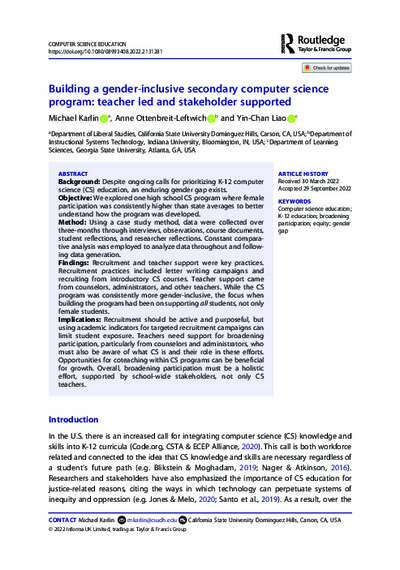Building a gender-inclusive secondary computer science programteacher led and stakeholder supported
Michael Karlin, Anne T. Ottenbreit-Leftwich, Yin-Chan Liao
Publikationsdatum:
|
 |
 Zusammenfassungen
Zusammenfassungen
Background: Despite ongoing calls for prioritizing K-12 computer
science (CS) education, an enduring gender gap exists.
Objective: We explored one high school CS program where female participation was consistently higher than state averages to better understand how the program was developed.br> Method: Using a case study method, data were collected over three-months through interviews, observations, course documents, student reflections, and researcher reflections. Constant comparative analysis was employed to analyze data throughout and following data generation.
Findings: Recruitment and teacher support were key practices. Recruitment practices included letter writing campaigns and recruiting from introductory CS courses. Teacher support came from counselors, administrators, and other teachers. While the CS program was consistently more gender-inclusive, the focus when building the program had been on supporting all students, not only female students.
Implications: Recruitment should be active and purposeful, but using academic indicators for targeted recruitment campaigns can limit student exposure. Teachers need support for broadening participation, particularly from counselors and administrators, who must also be aware of what CS is and their role in these efforts. Opportunities for coteaching within CS programs can be beneficial for growth. Overall, broadening participation must be a holistic effort, supported by school-wide stakeholders, not only CS teachers.
Von Michael Karlin, Anne T. Ottenbreit-Leftwich, Yin-Chan Liao im Text Building a gender-inclusive secondary computer science program (2022) Objective: We explored one high school CS program where female participation was consistently higher than state averages to better understand how the program was developed.br> Method: Using a case study method, data were collected over three-months through interviews, observations, course documents, student reflections, and researcher reflections. Constant comparative analysis was employed to analyze data throughout and following data generation.
Findings: Recruitment and teacher support were key practices. Recruitment practices included letter writing campaigns and recruiting from introductory CS courses. Teacher support came from counselors, administrators, and other teachers. While the CS program was consistently more gender-inclusive, the focus when building the program had been on supporting all students, not only female students.
Implications: Recruitment should be active and purposeful, but using academic indicators for targeted recruitment campaigns can limit student exposure. Teachers need support for broadening participation, particularly from counselors and administrators, who must also be aware of what CS is and their role in these efforts. Opportunities for coteaching within CS programs can be beneficial for growth. Overall, broadening participation must be a holistic effort, supported by school-wide stakeholders, not only CS teachers.
 Dieser wissenschaftliche Zeitschriftenartikel erwähnt ...
Dieser wissenschaftliche Zeitschriftenartikel erwähnt ...
 Personen KB IB clear | Maxwell Bigman , Paulo Blikstein , Gail Chapman , Sally Fincher , Joanna Goode , Richard Guenther , Mark Guzdial , Sarah Hug , Jane Margolis , Lijun Ni , Chris Proctor , Anthony V. Robins , Michael Wenk | ||||||||||||||||||||||||||||||||||||||||||||||||||||||||||||||||||||||||
 Begriffe KB IB clear | Bildungeducation (Bildung)
, GenderGender
,  growth mindset growth mindset growth mindset
, Informatikcomputer science
, growth mindset
, Informatikcomputer science
,  LehrerIn LehrerIn teacher
, teacher
,  Schule Schule school school
| ||||||||||||||||||||||||||||||||||||||||||||||||||||||||||||||||||||||||
 Bücher |
| ||||||||||||||||||||||||||||||||||||||||||||||||||||||||||||||||||||||||
 Texte |
|
 Dieser wissenschaftliche Zeitschriftenartikel erwähnt vermutlich nicht ...
Dieser wissenschaftliche Zeitschriftenartikel erwähnt vermutlich nicht ... 
 Nicht erwähnte Begriffe | Digitalisierung, Eltern, fixed mindset, Informatik-Didaktik, Informatik-Unterricht (Fachinformatik), Kinder, Lernen, Schweiz, Unterricht |
 Tagcloud
Tagcloud
 Zitationsgraph
Zitationsgraph
 Zitationsgraph (Beta-Test mit vis.js)
Zitationsgraph (Beta-Test mit vis.js)
 Zeitleiste
Zeitleiste
 Anderswo finden
Anderswo finden
 Volltext dieses Dokuments
Volltext dieses Dokuments
 |  Building a gender-inclusive secondary computer science program: Artikel als Volltext ( Building a gender-inclusive secondary computer science program: Artikel als Volltext ( : :  , 6441 kByte; , 6441 kByte;  : :  ) ) |
 Anderswo suchen
Anderswo suchen 
 Beat und dieser wissenschaftliche Zeitschriftenartikel
Beat und dieser wissenschaftliche Zeitschriftenartikel
Beat hat Dieser wissenschaftliche Zeitschriftenartikel während seiner Zeit am Institut für Medien und Schule (IMS) ins Biblionetz aufgenommen. Beat besitzt kein physisches, aber ein digitales Exemplar. Eine digitale Version ist auf dem Internet verfügbar (s.o.). Es gibt bisher nur wenige Objekte im Biblionetz, die dieses Werk zitieren.














 Biblionetz-History
Biblionetz-History